Timeline of Marquette History"No man is himself; he is the sum of his past." - William Faulkner Tyler’s historical novels span all of Marquette's history, with many key events included as noted below. This entire timeline, except events happening after 2011 and with historical photos, is included in the book My Marquette.
1671 - Father Jacques Marquette, Jesuit Missionary, holds a large Mass on the shore of Lake Superior, reputedly close to where the city of Marquette would one day be built. Read about it in Iron Pioneers. 1673 - Father Marquette and Louis Joliet leave Mackinac in two bark canoes to explore lands to the west, including the Mississippi River. 1675 - Father Marquette dies. 1797 - Frederic Baraga born in Slovenia, then part of the Austro-Hungarian Empire 1836 - Michigan territory representatives vote not to accept Upper Peninsula as part of boundary. Then Democrats at "Frost-Bit Convention" accept the U.P. as part of Michigan statehood bill. 1837 - Michigan becomes the 26th state, upon acceptance of the Upper Peninsula instead of the Toledo Strip, following the Toledo "War." 1840 - William Burt hired by Surveyor General to survey Upper Peninsula. 1843 - Upper Peninsula divided into 6 counties: Chippewa, Houghton, Mackinac, Marquette, Ontonagon, and Schoolcraft. 1844 - Iron Ore is discovered in Upper Michigan by William Burt when his compass goes crazy while he is surveying the land due to magnetic iron ore rocks. Read about it in Iron Pioneers. 1845 - Philo Everett, having heard of William Burt's discovery, travels to Upper Michigan. He meets Marji Gesick, a Chippewa Chief, who leads him to the site of iron ore where Negaunee is located today. The discovery begins the iron ore industry, resulting in more mineral wealth being mined than during the California gold rush. Read about it in Iron Pioneers. 1846 - Chief Marji Gesick promised a stake in the Jackson Mining Company. 1849 - The village of Worcester is founded by Amos Harlow, Robert Graveraet, Waterman Fisher, and Edward Clarke. Peter White comes to Marquette.The first school is in the Harlow home, as well as the first post office, and many church meetings. First teachers are Mrs. Dan Ball and Mrs. Samuel Barney. First students are the Harlow and Bignall girls. The first winter the inhabitants nearly starve to death until a supply ship arrives on Christmas Day. Read about it in Iron Pioneers. 1850 - Worcester is renamed Marquette. When the ship Manhattan docks in Marquette, Dr. Livermore eulogizes it and Marquette's future glory as an industrial mecca. Read about it in Iron Pioneers. 1851 - Bishop Frederic Baraga becomes the Bishop of the Diocese of Amyzonia, later named Marianopolita, and then finally, the Diocese of Marquette, consisting of the entire Upper Peninsula. - Peter White becomes county clerk. - The first white child, Joseph Bignall, is born in Marquette. - The First Methodist Church is founded. Read about it in Iron Pioneers. 1852 - Peter White named postmaster of Carp River post office, which puts Amos Harlow’s early post office out of business. - The Marquette School district is established. 1853 - Charles Harvey arrives at Sault Sainte Marie to begin construction of shipping canal - Dr. Morgan Hewitt and family come to Marquette. - Lake Superior (Cleveland) Iron Company organized - October 12: Bishop Baraga first visits Marquette and selects the site for its first church, eventually to become St. Peter's Cathedral. Read about it in Iron Pioneers. 1854 - Peter White tricks the U.S. Government about the amount of Marquette mail so the government will make sure regular mail delivery arrives from Green Bay, Wisconsin. Read about it in Iron Pioneers. 1855 - The Soo Locks open in Sault Sainte Marie, making shipping on the Great Lakes expand, especially for shipment of Iron Ore from Marquette's Harbor. Charles Harvey, later the founder of neighboring Harvey, Michigan is the designing engineer. - Marquette celebrates its first Independence Day on July 4th with a lavish party at Samuel Ely's home. - Peter White and Maynard open law firm specializing in real estate. - First two permanent docks are built in Marquette's Harbor in Iron Bay. - First locomotive, the Sebastopol, arrives in Marquette. A railroad line is built from Marquette to Negaunee. Read about it in Iron Pioneers. 1856 - First Catholic priest arrives in Marquette. - Amos Harlow and Charles Harvey found first Presbyterian congregation out of the Harlow home. - St. Paul's Episcopal Church is established in Marquette. 1857 - Peter White marries Ellen Hewitt, daughter of Dr. Morgan Hewitt. White becomes a land agent in Marquette. White also wins land grant in Michigan legislature for railroad to be built in Marquette. The city honors him by referring to him as The Honorable Peter White. - First UP state road links Marquette to Lanse. Regular stagecoaches begin between cities until railroad lines are built. - Robert Graveraet becomes first state senator from Marquette County. Read about it in Iron Pioneers. 1857 - 1858 - First pocket dock erected in Marquette by Cleveland Company with 100 pockets. It is believed Marquette will now become greatest port on Lake Superior and be capable of handling all iron ore shipped for many years to come. Read about it in Iron Pioneers. 1859 - State road built to link Marquette to Bay de Noc. - February 18, 1859: Marquette officially incorporated as a village. - Property for first high school donated. 1860 - Marquette's population reaches 1,000. 1861 - The Civil War begins. Upper Michigan sends a company for the Michigan 27th, including many Marquette men. Upper Michigan's Iron Ore a major resource for the Union to win the war. Read about it in Iron Pioneers. 1863 - Neighboring town of Harvey founded after the original Chocolay settlement destroyed by fire. 1864 - Completion of the Bay de Nocquet and Marquette Railroad's pocket dock, 30 feet high. - Peter White opens the First National Bank on May 10, 1864. Samuel Ely is president. - Cornerstone laid for St. Peter's Cathedral. Diocese now officially the Diocese of Marquette and Sault Sainte Marie. Read about it in Iron Pioneers. 1866 - Bishop Baraga dedicates the cathedral to St. Peter. Read about it in Iron Pioneers. 1867 - Peter White builds his first house on Ridge street. - Ursuline nuns found Marquette's first Catholic school. Read about it in Iron Pioneers. 1868 - Bishop Frederic Baraga dies. Succeeded by Bishop Mrak. - Marquette and Pacific Rolling Mill begins operations. Marquette Burns. Nearly 75% of city destroyed, including the entire business district and 2 of 3 docks. The residents are determined to rebuild. All business buildings must be built of stone from that time on, resulting in many fine examples of Lake Superior Sandstone architecture. - Alfred Swineford starts The Mining Journal. - The Fisher Street School is built. - Peter White is delegate for efforts for Upper Peninsula Statehood which fail. Read about it in Iron Pioneers. 1869 - Peter White named president of First National Bank of Marquette for rest of his life. Read about it in Iron Pioneers. 1870 - Jacobs takes over sandstone quarry. 1871 - Compulsory school attendance begins in Michigan. 1872 - Samuel Ely becomes Marquette mayor. To celebrate his friend's success, Peter White begins the first city library. - Marquette becomes connected to national railroads via Escanaba, Menominee, Chicago. Read about it in Iron Pioneers.
1874 - Charles Harvey builds the elevated railroad in New York City. - Harlow's Wooden Man is built. - First telegraph lines connect Marquette to Western Union. - Alfred Swineford becomes mayor of Marquette. He makes new efforts for Upper Peninsula Statehood. - St. Paul's Episcopal Church on Ridge Street begins construction. 1875 - Peter White gets legislative grant to build railroad from Sault Sainte Marie to Marquette. - Chandler runs as US Senator with goal to make Upper Peninsula separate state. Read about it in Iron Pioneers. 1877 - Bishop Mrak digs up what is believed to be Father Marquette's grave at St. Ignace Mission Chapel. Marquette's Park Cemetery opens, although had already been site of graveyard for several years. Read about it in Iron Pioneers. 1878 - Marquette Schools library books get home in First National Bank Building. 1879 - John M. Longyear marries Mary Beecher. - Bishop Mrak resigns his office because of ill health. Succeeded by Bishop John Vertin, the first Catholic bishop consecrated in the Marquette diocese. Bishop Vertin transfers St. Peter's priest. On October 2, St. Peter's Cathedral burns down. Rumors say it was done by parishioners angry at the bishop for their priest's transfer. Read about it in Iron Pioneers. 1881 - The Detroit Mackinac Railroad begins providing service over Mackinac Straits to lower Michigan. - June 19: Cornerstone laid for new St. Peter's Cathedral.
1883 - The Messiah Lutheran Church is built on Ridge Street. 1884 - Peter White builds a camp along the Laughing Whitefish River. Marquette Pacific and Rolling Mill ends operations. 1885 - U.S. President Grover Cleveland appoints Alfred Swineford as Governor of Alaska. 1886 - Peter White presents Presque Isle Park as a gift to the City of Marquette. He states: "The park belongs to the people of Marquette and must be preserved for all who in years to come shall call Marquette 'home'." Read about it in Iron Pioneers.
1888 - Soo Line Railroad begins providing service from Sault Sainte Marie to Minneapolis with stop in Marquette. 1889-1892 - The Longyear Mansion is built. It includes 65 rooms and a bowling alley in the basement. Covers an entire city block on Ridge and Cedar streets. Read about it in Iron Pioneers. 1889 - Marquette Post Office built at corner of Washington and Third Street. - First train to St. Ignace, on Detroit, Mackinac & Marquette Line leaves Marquette - Marquette Branch State Prison is built. Read about it in Iron Pioneers. 1890 - St. Peter’s Cathedral consecrated for use. - Ely Elementary School built on Bluff Street. Will later serve as the elementary school for St. John the Baptist's Catholic Church. - First street cars in Marquette Read about it in Iron Pioneers. 1891 - Harlow Wooden Man featured in a mock marriage ceremony. - Cleveland Iron Mining Co. and Iron Cliffs Co merge to form Cleveland-Cliffs Co. Ishpeming and Negaunee celebrate July 4th with Marquette - 5000 visitors for biggest celebration yet in Marquette. - Hotel Superior built. - Establishment of the Huron Mountain Club, an exclusive hunting and fishing club north of Marquette. Members will include the Longyears, Peter White, and Henry Ford. Read about it in Iron Pioneers. 1892 - New efforts for Upper Peninsula Statehood. The U.P. now has 180,000 residents, more than five other states currently in the Union. - Peter White gives the city library the Thurber block, later the site of the Nordic Theater on Washington Street. - The Marquette Opera House is opened, following funding efforts by Peter White and John M. Longyear. Read about it in Iron Pioneers. 1895 - Homer Kidder records Ojibwa tales of Chief Charles Kawbawgam. Read about it in Iron Pioneers. 1897 - Father Marquette statue is dedicated beside the new city waterworks building. Statue is said suspiciously to resemble Peter White who commissioned it. St. Luke's Hospital opens on Ridge Street. It will later become Marquette General Hospital. Read about it in Iron Pioneers. 1899 - Northern State Normal School founded. In dedication speech, Peter White declares Marquette will become an “Athens” of the North. 1900 - Howard Longyear drowns. His parents John and Mary Longyear wish to dedicate a park along the lakeshore for him but the city instead allows a railroad to be built angering Mrs. Longyear, who vows never to return to Marquette. - The Froebel School connected elementary, high and manual training building begin construction. Read about it in The Queen City. 1901 - Captain Cleary’s lifesaving crew from Marquette gives demonstration at the PanAmerican exhibition in New York where U.S. President McKinley is assassinated. - Louis G. Kaufman of Marquette gains majority control of First National Bank stock, but Peter White remains its president. - The Citizen's Home (the Marquette Poor Farm, later the Brookridge Estate) is built in South Marquette. - July 15, 1901 - Marquette's record hottest day, 108 degrees. Men took off their coats and walked around in just shirtsleeves! 1902 - Buffalo Bill's Wild West Show comes to Marquette. - The Hotel Superior closes. - Charles Kawbawgam, last Chief of the Chippewa, dies and is buried at Presque Isle. His wife Charlotte is buried beside him in 1904. Read about it in The Queen City. 1903 - Still angry at the City of Marquette, the Longyears have their enormous mansion dismantled and shipped on railroad car to Brookline, Massachusetts. Read about it in The Queen City. 1904 - Peter White library built at present location on Front and Ridge Streets. 1905 - Peter White organizes 50th anniversary celebrations of the Soo Locks. - The Bijou opens - Marquette’s first movie theatre. 1908 - Peter White dies while climbing steps of Detroit City Hall. The Mining Journal runs a special edition in his memory. - The ship Clemson sinks in Lake Superior. Read about it in The Queen City. 1910 - St. John the Baptist Catholic Church built on Washington and Fourth Streets. 1911 - Howard Taft is first U.S. President to visit Marquette. 1913 - The ship Henry Smith sinks in Lake Superior. - The famous Theodore Roosevelt trial takes place at the Marquette County Courthouse when an Ishpeming reporter slanders the former U.S. president in print by calling him a drunkard. Roosevelt wins the trial. Read about it in The Queen City.
1915 - The Holy Family Orphanage opens. It will be the Catholic children's orphanage until 1965. - A new St. Luke's Hospital is built in North Marquette. 1916 - Prohibition begins in Marquette County. The entire nation will be under prohibition from 1920-1933. Read about it in The Queen City. 1917 - Five ships trapped in ice on Lake Superior in month of May near Marquette. Marquette sends its young men as enlisted soldiers to train at Fort Custer for World War I. Read about it in The Queen City. 1918 - Marquette County Historical Society is founded. 1919 - Country of Norway purchases island of Spitzbergen from J.M. Longyear for $40 million. 1920 - Ferry service begins at the Mackinac Straits to transport vehicles between Upper and Lower Michigan. 1921 - Marquette Branch Prison Riot. Warden Catlin and Deputy Warden Menhennett killed. Read about it in The Queen City. 1922 - The City of Marquette buys Laurium's Palestra iceskating building and moves it to Marquette. - J.M. Longyear dies. 1924 - Marquette’s worst murder spree. Oscar Lampinen kills three men before Officer Walter Tippet shoots him.
1928 - Northern Normal School becomes Northern State Teachers College. 1929 - The Great Depression begins across the nation. Read about it in The Queen City. 1930 - Marquette's Northland Hotel (later the Landmark Inn) completed. 1931 - July 2: WBEO, the Mining Journal's Radio Station begins broadcasting. First radio station in Upper Michigan. Dr. Albert Hornbogen and a prisoner killed in Marquette Branch Prison riot. 1935 - St. Peter's Cathedral burns again. - The Presbyterian Church on Front Street opens. - Marquette's last streetcar quits running. Read about it in The Queen City. 1936 - The Nordic Theatre opens. 1937 - The second Marquette Post Office at Washington and Third Street opens.
1941 - Northern State Teacher's College becomes Northern Michigan College of Education. - U.S. enters World War II. Local volunteers watch the city skies from fear of air raids by the Nazis to bomb the ore docks. Read about it in The Queen City. 1942 - Louis G. Kaufman, president of First National Bank, dies. - George Shiras, famous local photographer and Peter White's son-in-law dies. - St. Michael's Catholic Church is established in a former dormitory bought from Northern Michigan College of Education. Read about it in The Queen City. 1949 - Marquette's Centennial. Celebrations include a beard growing contest and judging for best historical costumes. Marquette holds its biggest parade to date. Read about it in The Queen City. 1952 - Mike Chenoweth, winner of the centennial beard growing contest, is shot in Big Bay by Lieutenant Coleman Peterson. The murder will become the source of local writer John Voelker's Anatomy of a Murder. Read about it in Superior Heritage. 1954 - Mackinac Bridge, world's longest suspension bridge, begins construction to link Upper and Lower Michigan. It opens to traffic in 1957. Read about it in Superior Heritage 1955 - Northern Michigan Teachers College becomes Northern Michigan College. 1956 - Marquette’s first television station, WLUC TV 6 begins programming. Read about it in Superior Heritage 1957 - Peter White Public Library adds its annex. 1958 - Anatomy of a Murder by Robert Traver (pseudonym of John Voelker) published. 1959 - Anatomy of a Murder, based on John Voelker's novel (written under pseudonym Robert Traver) is filmed in Marquette County by Otto Preminger and stars James Stewart, Lee Remick, and many others. Marquette is "starstruck." Read about it in Superior Heritage 1960s - The U.S. 41 bypass is built, resulting in decline of downtown Marquette and the opening of Shopko, Kmart, and Marquette Mall. Read about it in Superior Heritage 1960 - The new Messiah Lutheran Church opens on Fourth and Magnetic Streets. 1962 - Nation's first snowmobile race takes place in Marquette. 1963 - Northern Michigan College becomes Northern Michigan University. 1965 - Bothwell Middle School opens. - First Baptist Church on Front St. burns down. A new church is built near Northern Michigan University. - The Messiah Lutheran Church is destroyed. - The second Clifton Hotel burns down. 1967 - Official "Pasty Day" first celebrated in the U.P.
1973 - St. Luke's Hospital and St. Mary's Hospital merge to become Marquette General Hospital. 1974 - Palestra Ice Rink torn down and replaced by the Lakeview Arena. 1975 - Upper Peninsula statehood on ballots in Marquette and Iron Mountain, but defeated 37.1% For, 62.9% against. Read about it in Superior Heritage 1978 - State Representative Dominic Jacobetti introduces bill for Upper Peninsula separation from Michigan and Upper Michigan statehood, but never brought to vote in State House of Representatives. - NMU students bake world's largest pasty, wrapped in 250 lbs of dough. 1985 - The historic Delft Theatre becomes a two screen movie house. Formerly it had had the largest movie screen in Upper Michigan. Read about it in Superior Heritage 1986 - John the Baptist’s Catholic Church is demolished to become a parking lot. The belltower is preserved. Its rose window now hangs in St. Michael's Parish. Read about it in Superior Heritage 1989 - 1992 - The Brookridge Estate (Marquette's Poor Farm) is destroyed. It will be replaced by the Brookridge Assisted Living Facility. - John D. Pierce School is destroyed, Northern Michigan University's original Teaching School. Read about it in Superior Heritage 1993 - Northern Michigan University's historic Longyear Hall, the last of its original buildings, is demolished despite public controversy. Ironically, NMU then begins preparing for its 100th anniversary by locating historical sites on campus. Read about it in Superior Heritage 1994 - U.S. Vice President Al Gore visits Marquette. - The Historic Delft Theatre becomes five screens, and the GKC Royal Cinema opens with 10 screens. - Dominic Jacobetti dies after being elected to the Michigan House 21 times. 1995 - The Nordic Theatre, site of the film Anatomy of a Murder's World Premiere, closes. The building is turned into Bookworld. - K.I. Sawyer Air Force Base closes, effecting the local economy. Read about it in Superior Heritage 1999 - Marquette's Sesquicentennial. Completion of the Presque Isle Pavilion as a gift to the city from the people of Marquette. - Northern Michigan University constructs its Seaborg Center and Berry Events Center. Read about it in Superior Heritage 2000 - Removal of the Soo Line trestle in downtown Marquette. - Upfront & Co., a restaurant and nightclub, opens in the old Rosewood Inn. - The Peter White Public Library holds its grand opening of its renovated building. 2001 - Controversy over deer being shot at Presque Isle Park, resulting in angry citizens referring to the event as Blood Island. - Marquette's Frida Waara joins 11 others to become the first women to ski to the North Pole. - Stand Up for Iron Ore rally against steel imports is held at the Superior Dome. - Sept 11: A plane of Japanese tourists makes an emergency landing in Marquette during the 9/11 terrorist attacks. The Great Lakes and Marquette's Harbor are under security watch. 2002 - Numerous of Peter White's original Lombardy Poplars are removed because they are dead or diseased along Lakeshore Avenue. 2003 - The historical Jacobs House is torn down on Front Street. - The Great Flood: May 11-12 heavy rains cause flooding. May 14-15, the dam at the Silver Lake Basin breaks. The Dead River overflows several feet above regular levels. All of Marquette north of Wright Street, 2,000 people total, is evacuated, from fear it will be underwater if the Hoist Dam also breaks. The bridge over the Dead River to Presque Isle Park is wiped out, prohibiting access to the Presque Isle Power Plant, resulting in the Empire and Tilden mines being shut down and people in Big Bay being without power. Tourist Park's beach is destroyed and the former lake becomes a river. 2004 - Marquette is named an All-America City, one of only ten in the U.S. - July 13, 2004 - President George W. Bush campaigns at the Superior Dome. He is only the second U.S. president to visit Marquette while in office. 2005 - International Finn Fest is held. Marquette's all time largest celebration. Read about it in The Best Place. 2006 - Tyler R. Tichelaar begins publishing his series of historical Marquette novels. - Alexander Sample is ordained Bishop of Marquette, youngest bishop in world at time of ordination, at age 45. Starbucks, Quiznos, and Papa Murphy's open. The founder of Starbucks is a graduate from Marquette's Northern Michigan University. 2007 - The Northwoods Supper Club closes after more than seventy years in business. - June 20, 2007 - the Great Hail Storm hits Marquette, damaging automobiles and homes. The streets are flooded, leaves and brush are left behind, and it is several days before the golf-ball size hail melts. - June 23, 2007 - The Shamrock Bar, after a hundred years in business, closes in Downtown Marquette. It is bought by the Wahlstrom family and becomes Elizabeth's Chophouse. 2009 - Fred Rydholm, former Marquette mayor, local historian and author of Superior Heartland dies. - May 18th is officially established as Founder's Day in Marquette to honor the arrival on that date in 1849 of Peter White and Robert Graveraet arriving in Iron Bay and being greeted by Chief Charles Kawbawgam. The first commemorative reenactment of the event is held at Founder's Landing at 6 a.m. -- Marquette County celebrates the 50th anniversary of the filming of Anatomy of a Murder. 2010 – The National Trust for Historic Preservation announces that Marquette is the winner of the 2010 Dozen Distinctive Destinations “Fan Favorite” award chosen by the public via an online vote – The Front St./US 41 Roundabout opens. – The Peter White Public Library receives the National Medal for Museum and Library Service. 2012 – May 10 - The Delft Theatre closes as a theatre after 97 years. May 10 – Bishop Frederic Baraga is declared “Venerable” by Pope Benedict XVI. September - Upfront & Company closes. 2013 – January – Alexander Sample, Bishop of Marquette, is promoted to Archbishop of Portland, Oregon, and installed in March in his new position. March - A new chapel begins construction at St. Peter’s Cathedral to house Bishop Baraga’s remains for veneration. December 28, 2013 – Sol Azteca, a Mexican Restaurant, opens. 2014 – February 1, 2014 – Bonanza closes after 37 years. February 11, 2014 – Rev. John Doerfler is ordained as the 13th bishop of the Catholic Diocese of Marquette. May 2014 – J.C. Penney leaves Marquette after more than twenty years in the Westwood Mall and being downtown on Washington Street prior to that for decades. |






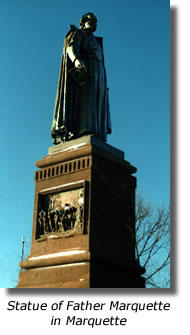 1637 - Jacques Marquette born, Laon, France.
1637 - Jacques Marquette born, Laon, France. 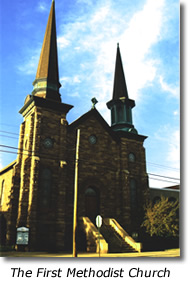 1873 - A financial panic causes many prominent Marquette citizens to move back East.
- John Longyear comes to Upper Michigan as a landlooker.
- First Methodist Church, Marquette's first sandstone structure built by Jacobs, erected on corner of Ridge and Front Street. Read about it in
1873 - A financial panic causes many prominent Marquette citizens to move back East.
- John Longyear comes to Upper Michigan as a landlooker.
- First Methodist Church, Marquette's first sandstone structure built by Jacobs, erected on corner of Ridge and Front Street. Read about it in 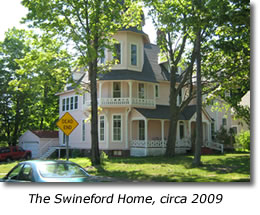 1882 - Alfred Swineford builds home on Cedar Street. Home includes several chimneys and an elevator. Read about it in
1882 - Alfred Swineford builds home on Cedar Street. Home includes several chimneys and an elevator. Read about it in 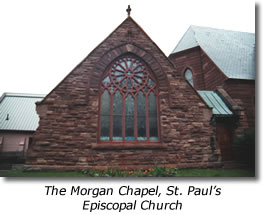 1887 - Peter White donates money to build the Morgan Chapel onto St. Paul's Episcopal Church in memory of his son Morgan who died young. Clifton Hotel burns down.
1887 - Peter White donates money to build the Morgan Chapel onto St. Paul's Episcopal Church in memory of his son Morgan who died young. Clifton Hotel burns down.  Originally includes a “men only” smoking room in basement.
- Marquette County Courthouse opened.
- September 17, 1904 - day of great Civic Pride for Marquette since both buildings are officially opened.
- Old County Courthouse is dismantled and lumber sold to Catholic Diocese for building of the Bishop Baraga school.
- Local author, Carroll Watson Rankin, publishes her popular children's novel Dandelion Cottage. Read about it in
Originally includes a “men only” smoking room in basement.
- Marquette County Courthouse opened.
- September 17, 1904 - day of great Civic Pride for Marquette since both buildings are officially opened.
- Old County Courthouse is dismantled and lumber sold to Catholic Diocese for building of the Bishop Baraga school.
- Local author, Carroll Watson Rankin, publishes her popular children's novel Dandelion Cottage. Read about it in 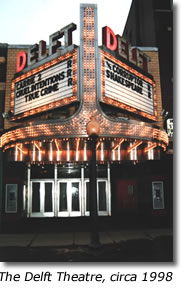 1914 - The Delft Theatre opens, and for many years, it will have the largest movie screen in Upper Michigan. Read about it in
1914 - The Delft Theatre opens, and for many years, it will have the largest movie screen in Upper Michigan. Read about it in 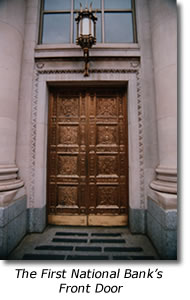 1927 - The new First National Bank is built on the corner of Washington and FrontStreets, the most expensive building per square foot built to date in the world.
1927 - The new First National Bank is built on the corner of Washington and FrontStreets, the most expensive building per square foot built to date in the world.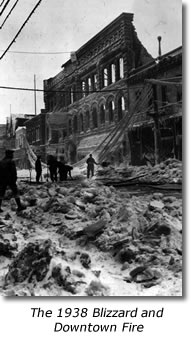 1938 - During a blizzard, Marquette's downtown catches fire. Rumored that a scandal in the Episcopal Church resulted in the burning of documents in the church's downtown office, which caused the fire. The Episcopal bishop had apparently been investing in Chicago nightclubs. Among other buildings, Marquette's Opera House is destroyed. Read about it in
1938 - During a blizzard, Marquette's downtown catches fire. Rumored that a scandal in the Episcopal Church resulted in the burning of documents in the church's downtown office, which caused the fire. The Episcopal bishop had apparently been investing in Chicago nightclubs. Among other buildings, Marquette's Opera House is destroyed. Read about it in 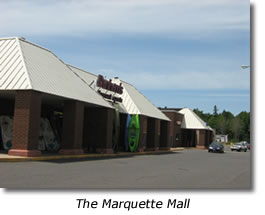 1972 - Efforts begin for the canonization to sainthood of Bishop Frederic Baraga.
- Public TV 13 (PBS) begins broadcasting at Northern Michigan University.
- Marquette Mall opens, the largest mall in Upper Michigan. Read about it in
1972 - Efforts begin for the canonization to sainthood of Bishop Frederic Baraga.
- Public TV 13 (PBS) begins broadcasting at Northern Michigan University.
- Marquette Mall opens, the largest mall in Upper Michigan. Read about it in 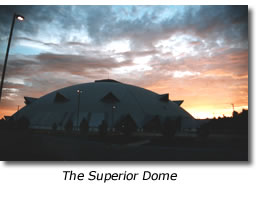 Northern Michigan University begins constructing the Superior Dome,the world's largest wooden dome. It is affectionately nicknamed "The Yooper Dome". Read about it in
Northern Michigan University begins constructing the Superior Dome,the world's largest wooden dome. It is affectionately nicknamed "The Yooper Dome". Read about it in 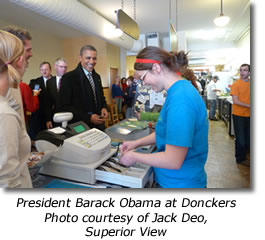 2011 – February 2: A bomb scare closes down Northern Michigan University’s campus. February 10: President Barack Obama visits Marquette. He has lunch at Donckers with Marquette Mayor John Kivela and then addresses a group at Northern Michigan University. The Marquette County Historical Museum moves to its new location on Third and Spring Streets, reopening as The Marquette Regional History Center.
2011 – February 2: A bomb scare closes down Northern Michigan University’s campus. February 10: President Barack Obama visits Marquette. He has lunch at Donckers with Marquette Mayor John Kivela and then addresses a group at Northern Michigan University. The Marquette County Historical Museum moves to its new location on Third and Spring Streets, reopening as The Marquette Regional History Center.